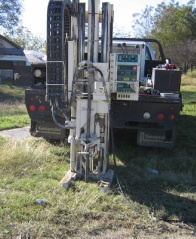Direct push drilling technology is a popular method for shallow soil investigations. This drilling method tends to be less expensive, takes less time, and creates less drilling waste. Direct push drilling equipment is smaller, truck or track-mounted, and more flexible so potentially more boreholes can be drilled and a larger area investigated. Drilling equipment manufacturers have engineered more safety features into direct push machinery. However, there are many aspects of conducting a drilling project that you should consider when planning soil investigation projects.
Primary areas of concern for safety include drilling personnel and their equipment, site conditions and preparations to drill, operation of equipment, and health and safety procedures. Professional environmental drilling companies that you may consider often can provide good information about equipment and site conditions, as well as any safety or logistical issues that need to be addressed for successful completion of your project.
The following general aspects associated with direct push drilling projects may give you some insight for your project planning.
Trained drillers: Use an environmental drilling company that provides employee training. Drillers should be familiar with the operator’s manual for their drilling equipment and knowledgeable of general safety procedures.
Experienced drillers: Use experienced drillers that are familiar with project sampling and testing methods to be used, and geologic conditions that may be encountered in your project area.
Knowledge of site conditions: Use a utility locate service (call 811) before drilling to identify any water sewer fuel or gas lines that may be present in the subsurface. Be aware of any overhead lines that may interfere with drilling or soft soil or slopes onsite and avoid them.
Proper equipment set-up: Set-up on flat ground is ideal. Avoid soft ground or slopes of more than 20 degrees (may result in shifting). Stabilize with outriggers but the machine should not be raised more than a few inches off the ground. Position the drilling machine upgradient from exhaust fumes.
Safety procedures: Wear appropriate personal protective equipment including steel-toed shoes, hard hat, safety glasses and outer covering such as Tyvek suits if contamination is suspected. Torn Tyvek should be replaced. Have a good first aid kit onsite. Drillers and consultants logging the boreholes should communicate regarding drilling actions, movement of the drilling machine, and a safe location for the consultant to perform their duties. Drillers and consultants should work under a health and safety plan that identifies site hazards, proper responses and location of important emergency services.
Project completion: After drilling the site should be returned to its condition prior to drilling. All project garbage should be collected and disposed, and drilling equipment properly cleaned for driving off-site. Any spills that occur should be cleaned up immediately; on-site spill kits provide the tools needed for most such incidents.
Texas environmental drilling company Talon/LPE has decades of combined experience on a variety of drilling projects throughout Texas, Oklahoma and New Mexico, including Direct Push Geoprobe. At Talon/LPE, safety always comes first. Contact us today to learn more about our environmental drilling company.

